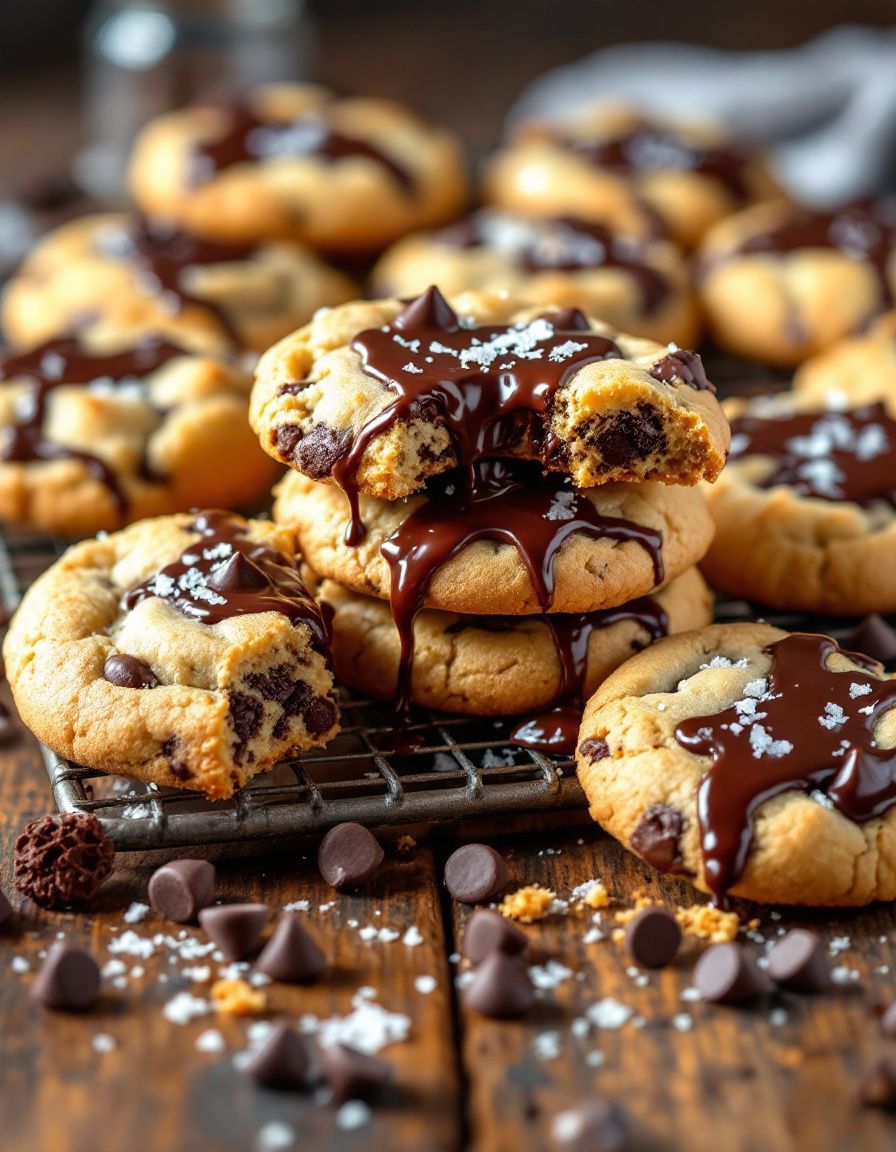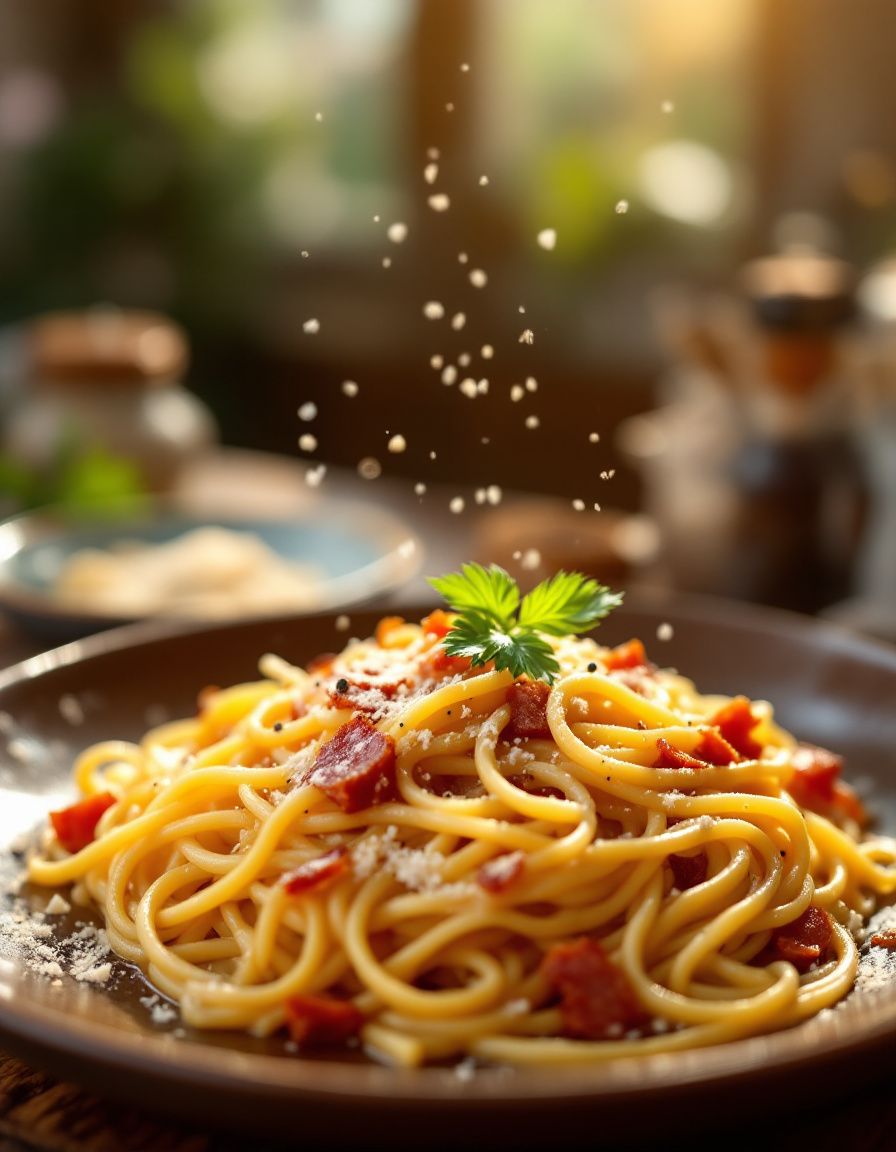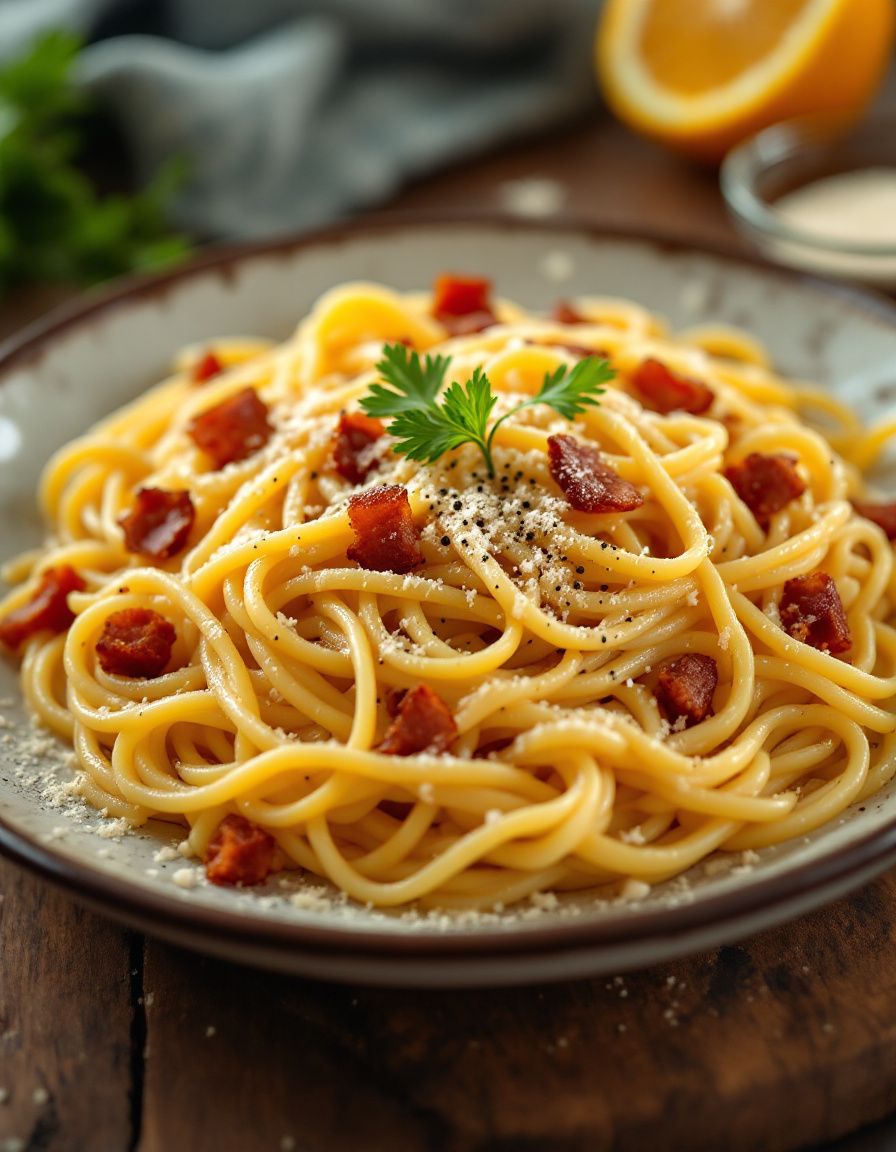Deliciously Irresistible Chocolate Chip Cookies: A Sweet Treat for Everyone
If you’re looking for a classic treat that never goes out of style, these Chocolate Chip Cookies are exactly what you need. The warm, gooey chocolate melty goodness combined with a golden, crisp edge and a chewy center makes these cookies a perfect indulgence for any gathering or cozy night in. From the moment you pull them out of the oven, the aroma fills your kitchen, creating a warm and inviting atmosphere that no one can resist.
Biting into one of these soft and chewy cookies is truly an experience. The rich, sweet caramel notes of the chocolate chips complement the buttery, vanilla-infused dough perfectly. These Chocolate Chip Cookies not only cater to your sweet tooth but also create lovely memories with family and friends. Gather your loved ones around the kitchen as you enjoy baking these delicious treats together.
Quick Recipe Highlights
- Flavor Profile: Expect a perfect balance of sweet, buttery dough and rich chocolate. The mix of semi-sweet and dark chocolate contributes to a depth of flavor, making each bite an absolute delight.
- Texture: Crisp on the outside, soft and chewy on the inside, these cookies deliver a satisfying melt-in-your-mouth sensation that is simply irresistible.
- Aroma: The heavenly scent of freshly baked cookie dough combined with chocolate fills the air, creating an enticing invitation for taste testers.
- Visual Appeal: Golden brown with large pools of melted chocolate, these cookies are a beautiful addition to any dessert platter.
- Skill Level Needed: This recipe is beginner-friendly, requiring only basic measuring and mixing techniques to achieve delightful results.
- Special Equipment: You’ll only need standard kitchen tools such as a mixing bowl, baking sheet, and cookie scoop for easy drop cookies.
Recipe Overview
- Difficulty Level: This Chocolate Chip Cookies recipe is easy enough for beginners yet allows for advanced bakers to get creative with added flavors and textures.
- Category: These cookies are categorized as desserts and snacks, perfect for any time of day.
- Cuisine: A beloved classic in American baking, Chocolate Chip Cookies originated in the United States and remain a staple in homes across the country.
- Cost: The ingredients are affordable, making this cookie recipe an economical choice for treating yourself or others.
- Season: While delicious year-round, these cookies shine particularly during holidays and gatherings.
- Occasion: Serve these cookies at birthdays, holiday parties, or simply bake a batch for a casual family movie night.
Why You’ll Love This Recipe
The appeal of Chocolate Chip Cookies lies in their delightful taste and texture. Sweet, buttery dough paired with melting pockets of chocolate creates a perfect harmony that keeps everyone coming back for more. With each bite, you experience the crispy edges giving way to a soft and chewy center, making it an unforgettable treat.
The convenience of this recipe cannot be overstated. With just a few common ingredients and straightforward instructions, you can whip up a batch of cookies in just 25 minutes. It’s a quick solution for satisfying a chocolate craving or for when unexpected guests arrive.
Nutritionally, these Chocolate Chip Cookies offer a boost from dark chocolate, which contains antioxidants. While indulging, you can feel a bit better knowing you’re also treating yourself to some beneficial ingredients.
These cookies are sure to steal the spotlight at any gathering. Whether served warm and fresh out of the oven or a day or two later, they provide the comfort and familiarity people love. Sharing them with friends and family during gatherings enhances their social value.
Economically, Chocolate Chip Cookies are an accessible dessert option. The basic ingredients are inexpensive and widely available, making it easy for anyone to enjoy these delicious treats without breaking the bank.
Historical Background and Cultural Significance
The origin story of Chocolate Chip Cookies dates back to the 1930s when Ruth Wakefield, the owner of the Toll House Inn, decided to experiment with chocolate in her butter cookie recipe. She expected the chocolate to melt and spread evenly, but instead, it retained its shape, creating the first-ever chocolate chip cookie.
Since then, Chocolate Chip Cookies have become an iconic American staple. Their immediate popularity led to partnerships with chocolate manufacturers, most notably Nestlé, who began producing the chocolate chips we know today. This cookie is now a fundamental part of American baking culture.
Over the years, the recipe has evolved, witnessing numerous adaptations and variations. Whether incorporating nuts, oatmeal, or diverse chocolate flavors, the classic cookie’s popularity endures, allowing for endless personal interpretations.
Regionally, variations of Chocolate Chip Cookies can be found across the United States, with some areas favoring specific chocolate types or additional ingredients like coconut or peanut butter chips. This adaptability speaks to the cookie’s universal appeal and cultural significance.
Ingredient Deep Dive
All-Purpose Flour:
All-purpose flour is the backbone of most baking recipes, providing structure and stability to cookie dough. It is essential for achieving the right texture and hold when baked. To ensure quality, choose high-protein brands for a chewy cookie and consider sifting to avoid clumps.
Granulated Sugar and Brown Sugar:
Using both sugars creates a balanced sweetness and contributes to a rich flavor and chewy texture. Brown sugar adds moisture with its molasses content, while granulated sugar helps achieve that coveted crispy edge. Always check for clumps when measuring and store sugars in airtight containers to maintain their consistency.
Butter:
Butter provides moisture and a rich flavor essential to delicious cookies. For best results, use unsalted butter, allowing better control over the recipe’s sweetness. Ensure your butter is at room temperature for easy creaming with sugars; if you run out, substituting with margarine can work in a pinch.
Chocolate Chips:
Chocolate chips come in various types, such as semi-sweet, dark, or even milk chocolate. Each adds distinct sweetness levels and flavor profiles to your cookies. Store chocolate chips in a cool, dry place to prevent melting, and consider swapping out for chunks or even white chocolate for unique twists.
Common Mistakes to Avoid
- Not measuring ingredients accurately can lead to incorrect ratios and result in flat or overly dense cookies. Always measure flour by spooning it into a cup and leveling it off.
- Using cold butter instead of softened butter will prevent proper creaming, affecting the overall texture. Allow butter to sit out for about 30 minutes before baking.
- Overmixing the dough can create tough cookies due to gluten development. Mix just until combined for tender results.
- Not chilling the dough can lead to cookies spreading too thin during baking. A 30-minute chill allows for better texture and flavor.
- Baking cookies on an ungreased baking sheet can cause them to stick; use parchment paper for easy release.
- Ignoring oven temperature can cause cookies to bake unevenly. Always preheat your oven and use an oven thermometer for accuracy.
- Baking them for too long can lead to overly crunchy cookies. Keep an eye on them; they should look slightly underbaked to achieve a chewy finish.
- Forgetting to rotate baking sheets halfway through cooking can lead to uneven baking. Make this a habit for consistent results.
- Using expired baking soda or powder will affect the rise of your cookies. Always check expiration dates and store them properly.
- Failing to let cookies cool on the sheet before transferring can result in breakage. Allow them to set for a few minutes first.
Essential Techniques
Creaming Butter and Sugar:
This fundamental technique is crucial as it introduces air, resulting in a light texture. To master this, mix softened butter with granulated and brown sugar until it becomes pale and fluffy. Avoid over-beating, which can lead to a greasy texture.
Chilling the Dough:
Chilling the cookie dough strengthens the fats, leading to a thicker cookie. To achieve this, simply wrap the dough in plastic wrap or place it in a covered bowl for at least 30 minutes. Watch for dough that feels firm but not frozen.
Correct Baking Times:
Baking cookies just until golden around the edges while remaining soft in the center is vital. Oven temperatures can vary, so utilize visual cues, such as slight browning, for optimal results. Rotate trays halfway through to ensure even cooking.
Pro Tips for Perfect Chocolate Chip Cookies
1. Consider using a mix of chocolate types for added flavor complexity – dark, milk, and white chocolate create an exciting array of tastes.
2. Experiment with different extracts like almond or hazelnut to enhance the overall flavor profile of your cookies.
3. For a chewy texture, slightly underbake your cookies and let them rest on the baking sheet before transferring them to a cooling rack.
4. Adding a pinch of flaky sea salt on top just after baking accentuates the sweetness and richness of the cookies.
5. For uniform cookies, use a cookie scoop for consistent sizing, allowing for even baking and presentation.
6. Use parchment paper instead of greasing the pan to easily lift cookies without sticking or breaking.
7. Try incorporating nuts or dried fruits for a unique twist and added texture.
8. If you’re after a deeper flavor, brown your butter before mixing it into the dough for a nutty finish.
Variations and Adaptations
Chocolate Chip Cookies can be customized to suit any taste preference or dietary need. Seasonal variations might include adding spices such as cinnamon or nutmeg for a festive touch during the holidays.
For those with dietary considerations, you can create gluten-free options by using almond flour or a gluten-free flour blend. Dairy-free alternatives can be achieved by substituting regular butter and chocolate with plant-based options.
Explore flavor variations by integrating peanut butter or Nutella swirls throughout the dough. Texture modifications could involve adding oats or crispy rice cereal for a delightful crunch. Presenting the cookies on vibrant plates or garnished with sprigs of mint can also elevate their appearance.
Serving and Presentation Guide
When plating Chocolate Chip Cookies, consider stacking them in groups of three or five for a visually striking display. Garnishing with a light dusting of powdered sugar or a sprinkle of sea salt can enhance their appeal.
Traditional accompaniments include a glass of cold milk, but for a modern twist, serve with coffee or a scoop of vanilla ice cream for an indulgent dessert.
Managing temperature is key; serve cookies warm from the oven for an at-home café experience or allow them to cool completely and pack in attractive treat boxes for gifting. Portion control can be achieved by using a cookie scoop for equal sizes every time.
Wine and Beverage Pairing
For a delightful dessert experience, consider pairing your Chocolate Chip Cookies with a glass of dessert wine, such as a late harvest Riesling or sweet red blends that complement chocolate’s richness.
For non-alcoholic alternatives, a rich mocha or herbal tea can beautifully balance the flavors of the cookies.
If you enjoy warm beverages, a rich chai tea or cold brew coffee can drink seamlessly alongside these sugary delights. Always consider serving temperatures to enhance taste – slightly chilled wines and warm drinks provide the best balance.
Storage and Shelf Life
To store your Chocolate Chip Cookies, place them in an airtight container at room temperature for up to a week. For extended freshness, store them in the refrigerator, where they can last up to two weeks.
Make sure cookies are completely cooled before transferring them to a storage container to prevent moisture buildup. If you notice any visible signs of spoilage, such as changes in texture or odor, it’s time to discard.
To reheat, simply pop them in the microwave for 10-15 seconds to regain that gooey texture or bake at 350°F for a few minutes. For longer storage, freeze unbaked cookie dough shaped into balls and store them in a freezer-safe bag; simply bake from frozen when the craving hits.
Make Ahead Strategies
You can easily prepare your Chocolate Chip Cookie dough ahead of time. Mix and form into balls, then refrigerate or freeze for later baking.
If freezing, allow dough rounds to harden on a baking sheet before transferring them to a sealed bag, which prevents them from sticking together.
This method helps retain freshness and flavor, ensuring that your cookies taste as if they were just baked.
When ready to bake, simply adjust cooking times by a couple of minutes to account for the chilled dough. Adding a sprinkle of salt on top just before baking boosts the flavors.
Scaling Instructions
If you want to halve the Chocolate Chip Cookie recipe, simply divide all ingredients in half, ensuring you have enough leavening agent to maintain texture.
For doubling or tripling, keep the ratios consistent and consider using multiple baking sheets for efficiency.
Be mindful of your mixing bowls; as the recipe scales up, you may require larger containers. Always cook a test batch to adjust timing to your liking, and ensure enough baking space.
When storing scaled cookies, keep in mind that larger batches may require separate containers to maintain freshness and texture.
Nutritional Deep Dive
In terms of macronutrient breakdown, a standard Chocolate Chip Cookie generally contains carbohydrates primarily from sugar and flour, fats from butter and chocolate, and a small amount of protein from flour.
Evaluating micronutrient content reveals that cookies are not a significant source of vitamins and minerals, though dark chocolate can offer antioxidants.
For those watching their intake, consider portion sizing; enjoying one cookie at a time can fit within a balanced diet.
On a weight management note, homemade cookies tend to be less caloric than store-bought ones, giving you control over added sugars and fats. Increasing the number of healthier add-ins like oats or nuts can improve nutritional value without sacrificing flavor.
Dietary Adaptations
For gluten-free Chocolate Chip Cookies, substituting with almond flour or a gluten-free all-purpose blend maintains texture and flavor without wheat.
Dairy-free options can be created using margarine and dairy-free chocolate to cater to lactose intolerance.
Vegan adaptations can include flax eggs as an alternative binding agent, and using maple syrup for sweetening.
Low-carb or keto variations involve substituting sugars with erythritol or stevia and wheat flour with coconut flour, maintaining great flavor while accommodating dietary preferences. Always test these substitutions for best results!
Troubleshooting Guide
If your cookies come out too flat, it may be due to excessive butter or not enough flour. Measure accurately and ensure butter is at room temperature.
An overly chewy cookie can result from under-baking; aim for nice golden edges while leaving the center soft.
If flavors are off-balance or lacking, consider adjusting your sugar ratios or adding a pinch of salt to enhance overall sweetness.
Oven temp discrepancies can lead to issues; always check with an thermometer if baking results vary.
For substituting ingredients, make sure alternate choices align closely with the original’s properties to maintain cookie integrity.
If your cookies seem too dry, this can be corrected with proper storage in an airtight container to retain moisture.
Recipe Success Stories
The community has embraced this Chocolate Chip Cookie recipe, with numerous readers sharing photos of their delightful results. Personalized adaptations have led to unique variations, showcasing how these cookies can evolve while still holding true to the classic original.
A number of readers have successfully introduced different flavors, receiving rave reviews. The flexibility of this recipe makes it an ideal starting point for creative experimentation.
Many bakers also highlight the joy of sharing warm cookies with loved ones, creating heartwarming experiences that resonate through the comments.
Feedback has repeatedly noted satisfaction with simplicity, affirming its accessibility for home bakers of all skill levels wanting to create memories through cooking.


